| Author |
Message |
Stephanie Maks

|
 Posted: Fri 24 Oct, 2008 9:37 pm Post subject: Some Q's about some 19th century swords Posted: Fri 24 Oct, 2008 9:37 pm Post subject: Some Q's about some 19th century swords |
 |
|
Before I got interested in modern reproductions / recreations, I was collecting some antique swords. Admittedly I didn't know too much, and just went with what appealed to my taste and budget more than anything else. I ended up focusing on 19th century sidearm / hangers mostly, and have collected a few of them. There's a few questions I've been wondering, especially lately now that I'm starting to expand my knowledge.
First up is a sword with a blade that I am fairly certain is not a phoney - it bears legitimate Chatellerault markings on the back of the blade, and has a proof mark on the ricasso which matches the year indicated on the back of the blade. The hilt arrangement though is quite unique. The sword is a hanger / briquette / falchion shape, with a rather wide fuller along both sides, but rather than a D shaped / stirrup hilt as I would have expected on this blade, it has a rather plain circular brass guard, then a horn (or fake horn) grip. The length is 24" overall, with a blade of 18.5" There had been a brass cap on the end of the grip that had been held in place with some crumbly white glue/plaster, but the sword was knocked off its display and this cracked the "glue" loose. Just inside where the pommel cap had been, the end of the square tang is just visible. Aside from the manufactory and proof markings, the blade bears an engraved anchor on either side, just below the ricasso. My question is, does this hilt arrangement appear legitimate? Might it be a case of a military sword being converted into a hunting sword, or does this look more like a mash-up job?
My other question relates to the edges and sharpness of swords of this type and era. The second picture shows a trio of 19th century military sidearm swords. From left to right they are:
1. Alledged to be a Wagon Driver's sidearm, thought to be English. (Marked with a D on the guard) Length overall: 28", Blade: 21.5"
2. A typical naval cutlass / hangar / briquette, also thought to be English. (Marked B&W on the ricasso) Length overall: 30.5", Blade: 24"
3. A Prussian Infantry Sidearm, pattern M1852. (Very thoroughly marked & researched, dated 1870) Length overall: 24", Blade: 18.5"
The second question is, none of these swords are sharp - why not? They are pointy - if you got jabbed with one it would smart - but the edges are dull dull dull, in some cases almost 1mm thick. Did they not bother sharpening them because they were only for show? Or could they have been dulled later, like decomissioned and dulled? That doesn't seem likely to me that all of them would have this happen. Or - is it possible that previous owners in Europe had them dulled due to modern restrictions? In the case of the "B&W" cutlass, this does look plausible - the geometry / profile of the blade looks to me that it could be 'wider', i.e. that a few mm where the edge would be could have been shaved off. The other two, though, look like they simply were never meant to be sharp. Ditto the Chatellerault blade, it looks like it has never been sharpened.
I have a fifth sword of this era, which is sharp. Not as sharp as an Albion or ATrim, but sharp. I received it in worse-condition than any of the four pictured below. It just puzzles me that out of five 19th century military swords, only one should be sharp. One last comment, I acquired all of these between 4 and 6 years ago, from various sources - Canada, USA, Europe.
Thanks!
Edited to add: Sorry, the pics came out in the wrong order!
 Attachment: 95.4 KB Attachment: 95.4 KB
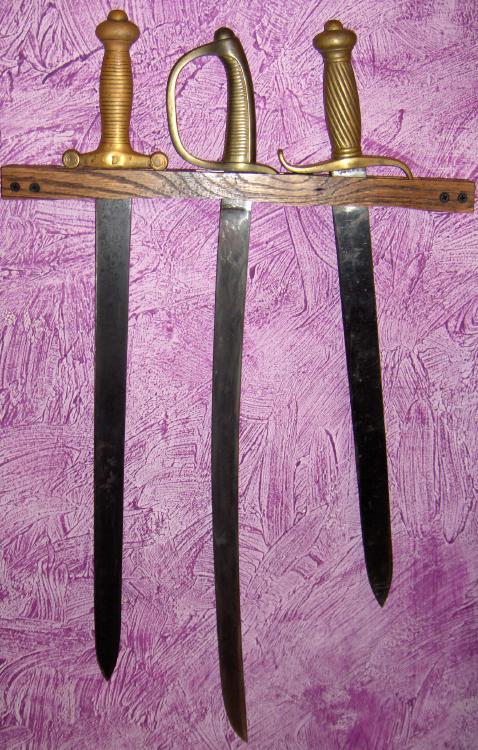
Three 19th century military sidearm swords
 Attachment: 117.29 KB Attachment: 117.29 KB
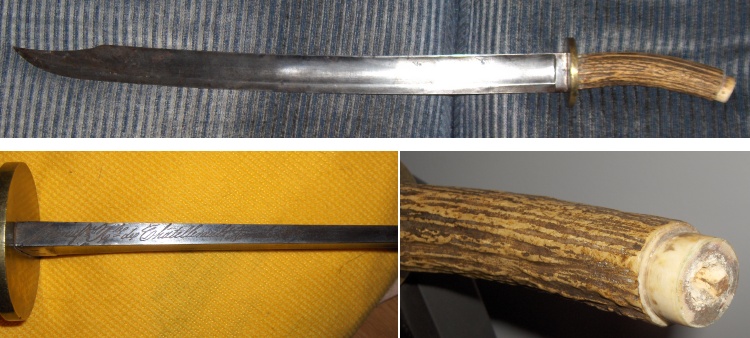
Manufre. Rle de Chatellerault Avril 1847
|
|
   |
 |
Sa'ar Nudel

|
 Posted: Sat 25 Oct, 2008 1:44 am Post subject: Posted: Sat 25 Oct, 2008 1:44 am Post subject: |
 |
|
Hi, I'll try to answer some of the subjects to my best, I was too into military swords for some time, but not very thorough.
The 'hunting sword' looks like a mash-up; the blade was probably taken off a naval bayonet and reground, the grip looks like a legit old stag but the disk guard indicates a somewhat hasty work. re-fitting old bare blades or re-using broken blades was very common during both World Wars as a method of creating a makeshift or side weapons. It may be so also in your case but it should be checked personally.
Most military swords - in fact most military edged weapons of the 19th century (and partly the 20th c.) were delivered dull from the arsenal. The assumption was that the issued soldier should have sharpened his blade himself. Most soldiers just ignored that, but occasionally I see sharpened swords with an evidently old edge, sometimes the edge shows signs of a master craftsman, hence no grinding marks and a smooth surface. Some edged weapons were not intended to be sharpened at all, being issued as processional pieces - such as band sword.
Your 'Wagon Driver's Sidearm' has a hilt of a French pattern 1831 sidearm, known also as 'Cabbage Cutter' and 'Roman Style' (they were also issued to the South during the US Civil War). The blade is significantly smaller in all dimensions and it seems it lacks the massive central ridge and its wasp-waist. There was, however, a smaller model with a hilt of identical form, issued in Russia. The original French sword can be found mostly with sharp edges.
The Briquet, again has nothing to do with the UK. Original pattern was French too, 1816, and there were a lot of them issued both on land and sea in France, Belgium and Prussia with very small different details.
Unfortunately the marks are my weak side. I can only tell that good quality replicas were struck with the letter R on the ricasso. Dishonest owners could have 'improved' the R into something else in order to represent the item as original.
Curator of Beit Ussishkin, regional nature & history museum, Upper Galilee.
|
|
   |
 |
Stephanie Maks

|
 Posted: Sat 25 Oct, 2008 5:29 am Post subject: Posted: Sat 25 Oct, 2008 5:29 am Post subject: |
 |
|
Thanks for the information Sa'ar! I did not know that it was standard practice for the armoury to deliver the sword with an unsharpened edge, that information is very good to know.
Re. the mash-up, what you've said makes good sense and the plain disk guard really does reveal a lot about the thought that was put into it (or not put into it as the case may be).
Re. the 'wagon driver' sword, I'm actually familiar with the pattern 1831 "Cabbage Cutter" and tried a few times to get my hands on one. This sword is not IMHO related to the cabbage cutter - I neglected to mention that it is a single-edged sword. That's why the central ridge appears 'missing'. The blade dimensions and the grip dimensions are all too small for the cabbage cutter, and with the single-edged blade, I do not believe this sword is meant to be a replica (modern or historic) of those French swords. Of course, it's quite possible that the 'wagon driver' thing isn't true... but anyhow, my main questions have been answered so I'm happy. 
Cheers!
|
|
   |
 |
Stephanie Maks

|
 Posted: Sat 25 Oct, 2008 5:42 am Post subject: Posted: Sat 25 Oct, 2008 5:42 am Post subject: |
 |
|
Just for the heck of it, here's a pic of the fourth sword I mentioned - another cutlass, this is the only one that I have that is sharp.
It is 'unmarked' except for a single half-mark on the blade below the ricasso. The mark looks like it was partially lost during the polishing / sharpening process, and for a while I tried to figure out what the mark was, with all the internet resources I could find, and book resources I could find (which weren't many.)
Cheers!
 Attachment: 66.96 KB Attachment: 66.96 KB

 Attachment: 88.86 KB Attachment: 88.86 KB
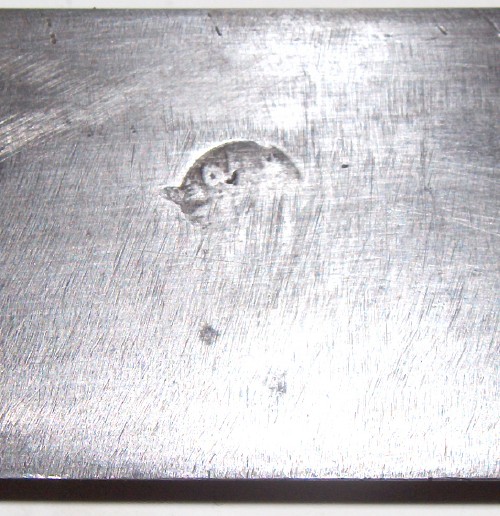
|
|
   |
 |
Ian Hutchison

Location: Louisiana / Nordrhein-Westholland Joined: 27 Nov 2007
Posts: 626
|
 Posted: Mon 27 Oct, 2008 9:09 am Post subject: Posted: Mon 27 Oct, 2008 9:09 am Post subject: |
 |
|
| Stephanie Maks wrote: | Just for the heck of it, here's a pic of the fourth sword I mentioned - another cutlass, this is the only one that I have that is sharp.
It is 'unmarked' except for a single half-mark on the blade below the ricasso. The mark looks like it was partially lost during the polishing / sharpening process, and for a while I tried to figure out what the mark was, with all the internet resources I could find, and book resources I could find (which weren't many.)
Cheers! |
Hmm, might that be a weakly stamped Turkish briquet? They were modeled after the French 1816 pattern
Here's a picture of the Turkish marking for comparison:
Looks almost exactly the same as your marking. Notice the rectangular indent on the edge of the semi-circle.
 Attachment: 40.9 KB Attachment: 40.9 KB
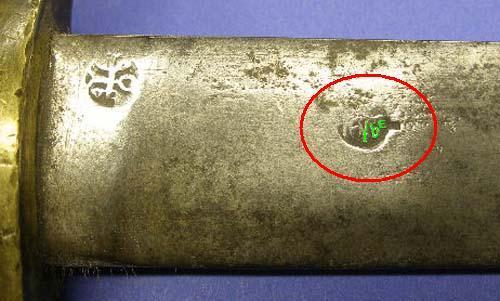
 Attachment: 49.1 KB Attachment: 49.1 KB
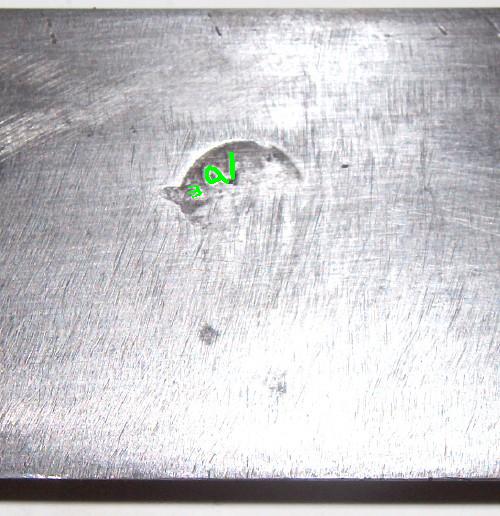
'We are told that the pen is mightier than the sword, but I know which of these weapons I would choose.' - Adrian Carton de Wiart
|
|
  |
 |
Stephanie Maks

|
 Posted: Mon 27 Oct, 2008 9:32 am Post subject: Posted: Mon 27 Oct, 2008 9:32 am Post subject: |
 |
|
Thank you Ian! I see that, it does look very similar. The mark in your image looks cleaner but I can see a few points that match up, when I rotate my image 180 degrees. Perhaps the stamp they used on my sword was wearing-down, or the sword has just been polished a little too zealously in it's lifetime...
The other mark you included, that is on the stirrup part correct? I will have another look at mine when I get home... as you can see in my picture, it's quite tarnished and it's also rather beat-up but there are a few indentations in it. It's hard to tell if they were stamped intentionally or as the result of use / wear&tear.
Thanks again - this is great information!
Edited to add: Hehe I see we both were looking at the same thing at the same time! 
 Attachment: 60.96 KB Attachment: 60.96 KB
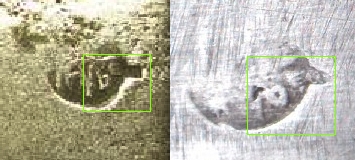
|
|
   |
 |
Ian Hutchison

Location: Louisiana / Nordrhein-Westholland Joined: 27 Nov 2007
Posts: 626
|
 Posted: Mon 27 Oct, 2008 9:37 am Post subject: Posted: Mon 27 Oct, 2008 9:37 am Post subject: |
 |
|
| Stephanie Maks wrote: | Thank you Ian! I see that, it does look very similar. The mark in your image looks cleaner but I can see a few points that match up, when I rotate my image 180 degrees. Perhaps the stamp they used on my sword was wearing-down, or the sword has just been polished a little too zealously in it's lifetime...
The other mark you included, that is on the stirrup part correct? I will have another look at mine when I get home... as you can see in my picture, it's quite tarnished and it's also rather beat-up but there are a few indentations in it. It's hard to tell if they were stamped intentionally or as the result of use / wear&tear.
Thanks again - this is great information!
Edited to add: Hehe I see we both were looking at the same thing at the same time!  |
Ah yes, rotating it is much clearer than my poor attempt in MS paint. Looks like a match.
When you get home look for this on the "D" guard. You might try pinching the guard and running your fingers down the length if you can't see any mark. It may be that you can still feel a depression or some uneveness.

'We are told that the pen is mightier than the sword, but I know which of these weapons I would choose.' - Adrian Carton de Wiart
|
|
  |
 |
|
|
You cannot post new topics in this forum
You cannot reply to topics in this forum
You cannot edit your posts in this forum
You cannot delete your posts in this forum
You cannot vote in polls in this forum
You cannot attach files in this forum
You can download files in this forum
|
All contents © Copyright 2003-2025 myArmoury.com — All rights reserved
Discussion forums powered by phpBB © The phpBB Group
Switch to the Basic Low-bandwidth Version of the forum
|

